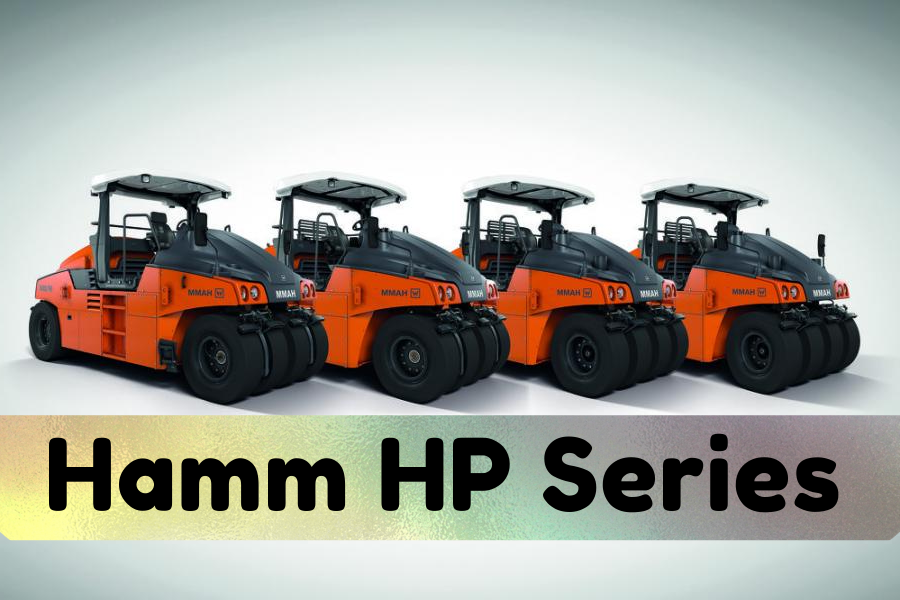Hamm HP Series Pneumatic Rollers – A pneumatic roller, also known as a rubber-tired roller, is a heavy-duty construction vehicle used for compacting soil, asphalt, and other materials. It’s equipped with multiple rows of pneumatic tires arranged on two or more axles, typically with three or four tires on the front axle and four or five on the rear. The tires are designed to provide a kneading action that compacts the material efficiently, while also offering some flexibility to adapt to uneven surfaces.
Here are some key features of pneumatic rollers:
- Versatility: They can be used on a variety of materials, including soft subgrades, base materials, bituminous mixes, and cold-laid asphalt.
- Maneuverability: The pneumatic tires allow for better maneuverability compared to steel drum rollers, making them suitable for smaller work areas or around obstacles.
- Compaction method: They provide a kneading action that helps to knit the material together, resulting in a denser and more stable surface.
- Adjustable weight: The rollers can be ballasted with additional weight to increase their compaction force.
- Applications: Pneumatic rollers are commonly used in road construction, pavement maintenance, and landscaping projects.
Here are some of the specific types of pneumatic rollers:
- Static pneumatic rollers: These rollers rely solely on the weight of the tires for compaction.
- Vibrating pneumatic rollers: These rollers have a vibrating mechanism that helps to break up the material and improve compaction.
- High-speed pneumatic rollers: These rollers are designed for high-speed compaction of asphalt pavements.

Hamm Roller Controls
Hamm rollers come in various models and configurations, each with its own set of controls. However, some general control features are common across many models:
Steering:
- Steering wheel: The primary steering control for most Hamm rollers.
- Articulated steering: For models with articulated frames, a lever or switch controls the articulation angle between the front and rear sections.
- Travel direction levers: Some models use levers instead of a steering wheel for direction control.
Driving:
- Throttle lever or pedal: Controls engine speed and forward/backward travel.
- Transmission levers or buttons: Selects the desired gear.
- Brake pedal: Applies brakes to both axles.
Compaction:
- Vibration levers or switches: Controls the amplitude and frequency of drum vibration.
- Oscillation switch (VO models): For models with vibration and oscillation drums, activates the oscillation mode.
- Water sprinkling system: Controls the water flow onto the drums for dust suppression and adhesion.
Additional controls:
- Hammtronic system: An electronic control system that manages various functions like automatic engine speed adjustment, startup/braking, and steering programs.
- Edge pressing and cutting devices: Levers or buttons to control optional attachments for asphalt edge finishing.
- Tire inflation system: Controls air pressure in the tires (on some models).
- Display panel: Shows machine information like operating speed, vibration frequency, fuel level, etc.
The operator’s platform, water-and-additive sprinkling system, and ballasting system have all been upgraded on Hamm HP Series pneumatic-tire rollers.
All model variants in the series share a common platform, including HP 180/HP 180i models with operating weights ranging from 8 to 18 tonnes and HP 280/HP 280i models with operating weights ranging from 10 to 28 tonnes.
The operator’s platform gives him or her a bird’s-eye view of the machine and the job site. The ISO 5006-2017 operator’s field of view standard is met by all models. The HP Series has a small number of switches on the operator’s platform, and color-coded groupings aid in operator guidance.
The joystick on the armrest is used to control the vehicle. Because the brake pedal is a part of the seat-operating unit, it is accessible regardless of seat position.
The new machines use the Hamm asymmetrical-frame concept, which allows for a clear view of the outer flanks of the front and rear wheels by providing track offset between the front and rear wheel sets.
The new machines also have ballasting flexibility, which allows the operating weight to be quickly adjusted to suit the asphalt type, layer thickness, and application. Steel or concrete prefabricated ballast bodies can be inserted or removed from the large ballast compartments between the wheel set.
A redesigned water tank is large enough to last an entire working day without needing to be refilled. According to Hamm, a 1,500-liter supplemental water tank is available and can be used as a water reservoir for the sprinkling system or as a flexible supplemental weight.
Interconnecting pipes connect the supplemental water tank to the basic water tank. A C-pipe connection complements traditional filling for quick refilling, allowing the entire tank to be filled in under three minutes.
Special asphalts require spraying an additive onto the roller’s pneumatic tyres, which is stored in concentrated form in the additive tank and mixed with water as needed.
For various addition levels, the additive tank has a level monitoring system that is controlled from the operator’s platform. During compaction, the roller doses and mixes the additive according to the specification.